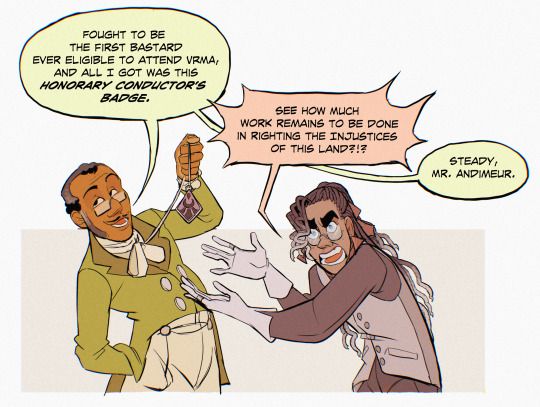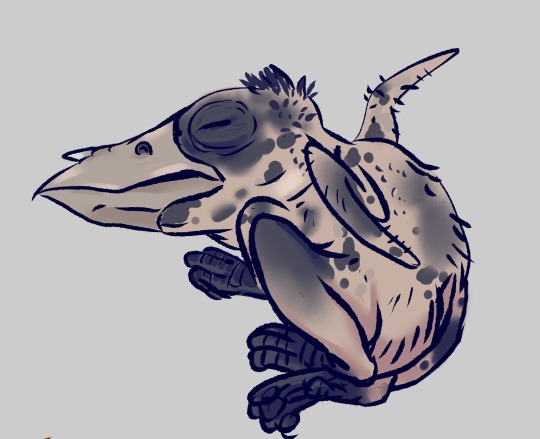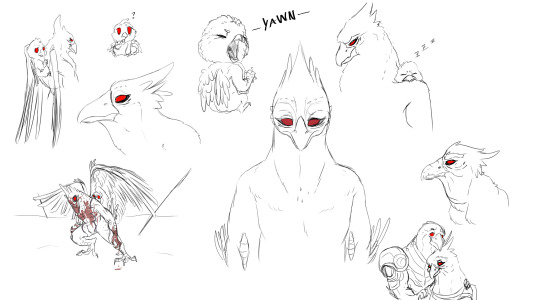#making his screechy little cameo
Explore tagged Tumblr posts
Note
I'm curious about the nobility in Vestur! What-all are the different kinds of noble titles? Since the Gift is hereditary, how are illegitimate children treated? Since relics get passed down, do nobles in the same line usually conduct the same kinds of meur?
What-all are the different kinds of noble titles?

A midland illustration from the 1500s, meant to demonstrate for children that nobility is in service of the commoner. It depicts a fantastical act in which the lord conducts blue meur to forms a river, signifying ownership over the land. The viscount then nourishes the earth with green meur, so the commoner may grow food for all.
While Vestur is ahead of much the world in the realms of standard of living and technology, the social order is antiquated compared to other contemporary nations. Vestur still functions on something of a feudal system. There are only three ranks in the noble hierarchy, with little socialmobility except through marriage.
The Tri-Kingdom is an alliance of three sovereign kingdoms, each of which are headed by a Monarch: an Archduke/Archduchess, or High King/Queen if occupying the High Throne. Vestur’s Monarchs are absolute rulers, with ultimate executive, judicial, and legislative power. Of course, in the modern day such authority is wielded with a cautious hand, and a monarch will often defer to the expertise of various councils rather than rule by his own intuition alone. The High King may override the word of an archduke or archduchess in especially perilous situations, or regarding matters of the meur economy, but they are (theoretically...) considered equal on all other matters and in full control of their respective kingdoms. The son or daughter of a Monarch are referred to as Duke/Duchess, or Prince/Princess.
A Lord or Lady of the Land holds authority over a specific territory, or lordship. Lords oversee the appointment of viscounts within their province, collect taxes, and whatever other administrative tasks their land might need. They are ultimately beholden to their kingdom's Monarch, but are given the freedom to define local laws and run their own courts (so long as the offense doesn't involve another lordship or kingdom). The son or daughter of a lord/lady are referred to as Master or Mistress.
Both monarchs and lords pass their title by blood, following primogeniture-esque laws of succession. Eldest son is the preferred heir, of course, but in absence of any suitable men, a seat of power will turn to the brothers of the current monarch/lord. Technically, a daughter can claim right to succession if her family has no sons, though this is a politically risky move and she may face consequence for it should she "steal" power from a more popular relative in doing so.
The final noble title is the only one not to follow this system of succession:
Viscounts/Viscountesses are an appointed title, and culturally thought to be one you “earn.” In reality, if your mother or father holds a viscount title, it's extremely likely you will be granted one as well. Appointments are given based on a meur-related service the viscount can provide to his/her lordship. One viscount may provide green meur based soil enrichment to a specific town. Another may own the local quern, powered by a blue meur water wheel. viscountry is largely seen as the reward for fulfilling your pledge. To compare with the real world, if taking your pledge is like receiving your university degree, viscountry means you’ve established a career with that degree.
There are untitled nobles as well, but that’s... an embarrassing role to occupy socially, and one assumed to be caused by being too lazy or inept to be appointed a viscount title. In reality, there are many reasons someone might be untitled: They might not own gloves - the visual mark of nobility, and without which performing meur in public is illegal (and a grievous, heretical insult to The Architect, according to men of faith). They might be from a fallen family and unable to afford a relic. And some may, for personal reasons, choose not to use their gift at all.
Since the Gift is hereditary, how are illegitimate children treated?

Prince Lucas chose specifically to read law under and clerk for Mr. Beiric, who challenged the Crown on the eligibility of bastards to VRMA. Beiric was born to a common mother, but sired by a noble father. Though too old to attend VRMA after his landmark win, he received an honorary conductor’s pendant. (Black, signifying he is not allowed to conduct at all.)
“Half-common bastards” (as the lovely people of Vestur call them) are considered nobility, but this is a twenty year old development. The scientific “realization” that The Gift doesn’t get diluted or lessened by having only one noble parent is less than a century old. It took the courts some time to catch up.
But... the outlook of a bastard attending the Vestur Royal Military Academy isn’t great. While the school has loaner gloves, unless the noble parent or some benevolent benefactor is willing to give a pair of priceless unicorn hide gloves to the illegitimate child, they could never be able to conduct meur legally post-graduation. Most noble families guard their gloves jealously, and few would deign to waste them on a “mistake.”
Do nobles in the same line usually conduct the same kinds of meur?
It depends on the family whether or not they tend towards one kind of conduction. Some have a generational reputation to uphold, or possess a famed historic relic.

Among old white conductor families, the pressure is immense. White meur is famously the hardest pledge to take, requiring an aptitude exam and an extra two years of education after graduation from VRMA. Those who fail the aptitude exam must shamefully pick a second option. (Drawn by @lsdoiphin!)
Tradition aside, relics are expensive, even for nobility; some families conduct one color for financial reasons rather than upholding a legacy. If dad’s old hand-me-down blue relic is all you can ever hope to afford... you're going to take a blue pledge and become a blue conductor.
But no one is forced to take a specific pledge, legally speaking. Everyone is free to choose their own pledge/conduction specialty at the end of their education... so long as they can live with the consequence.
#worldbuilding#fantasy world#fantasy setting#magic weapon#magic system#nobility#LONG POST WHEEE thanks for this ask... it was fun to draw for#others art#since ls contributed to this one#world: forever gold#lore dump#oc: lucas#making his screechy little cameo
72 notes
·
View notes
Note
What are your headcanons regarding chozo newborns/fledgelings?
OH BOY do I have information for you.
A few basics:
Chozo lay eggs.
Most Chozo are born with an egg tooth on the tip of their beak which helps them break free of the shell to be born.
"Boriha" is a Chozo word used to describe children who have yet to fledge.

Chozo hatchling (very new guy edition) with an egg tooth.
The Chozo tribes evolved with different traits on their homeworld, which have only diverged further following their departure.
Mawkin and Thoha hatchlings are altricial: they're born blind and depend wholly upon their parents for the first few months. It takes two weeks for altricial babies to gain a full coat of down.
Thiloo (a tribe of penguin-like Chozo) hatchlings are semi-altricial: they open their eyes within the first 24 hours of hatching, and are born with a thin coat of down that reaches full thickness within three days.
Hatzu (ratite Chozo: think emu, ostriches, and cassowaries) babies are precocial upon hatching: their eyes are open, and they're covered in natal feathers. The strong-legged Chozo of the Hatzu tribe are the only ones capable of walking fresh out of the shell. The Hatzu are the only Chozo who lack an egg tooth: instead, their babies kick their way out of their shells.
There are more tribes than I've listed here, but the Thiloo and Hatzu have the most notable differences upon birth.
Pictured below: a Thoha baby, a Thiloo baby, a Hatzu baby, and two images of newly-hatched baby Raven Beak. The altricial babies look like little naked old men (not unlike many real baby birds: shout outs to baby pelican).





The Hatzu kid pictured above is being picked up by an adult: the most stable method is to place your hands under the kid's chest and lift. Most Hatzu hatchlings will start to panic if their legs are restrained: it's a survival instinct.
Most Chozo babies use their sharp talons to grasp the downy feathers on a trusted adult's neck, chest, and back. It takes about two months for a hatchling to be able to reliably grasp. Grasping is how baby Chozo get around for the first few years of their lives. 18 months is around the time Chozo will be able to stand and walk independently, but they still rely on their parents to carry them around long distances.
That's not to say they'll rely solely on their parents for locomotion: once those babies can run, they run.



A few examples. The large compilation image is of Raven Beak's mother with a cameo from the big (little) guy himself.
Baby Chozo ask for food by nudging the nearest adult's throat or negging them with screechy cries. The corners of their beaks are flexible and pronounced at this age so they can open their gullet wide for room service. They can eat some solid food (little bits torn off of an adult's dinner, grubs, small insects), or their parents can regurgitate nutritious, partially-digested matter from their crop.

Raven Beak and his dad. Baby guy opens very wide for optimal screechage and to ensure oncoming food makes it into his face-hole.

Pictured above: a Thiloo hatchling (left) and a Thoha hatchling (right). The corners of the Thoha kid's mouth are brighter and more flexible than that of an adult, allowing it to open comically wide.

Doodles of a newborn baby Mawkin and one with natal feathers (not to scale).

Hatzu hatchling doodles.
Chozo kids begin to fledge properly around five years old and learn to fly at seven. Mawkin children can start the preliminaries for their combat training as early as four and a half, but training starts in earnest at six.
This post talks about child-rearing practices and feeding. This post has more information about Chozo eggs and a basic child development roadmap.
22 notes
·
View notes